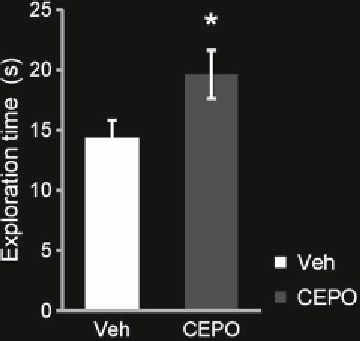Biology Reference
In-Depth Information
Fig. 3
Novel object exploration is increased in mice that received 4 daily admin-
istrations of CEPO (30
g/kg, i.p.). Novel object exploration was conducted one
day after the last CEPO administration. *
p
= 0.05,
n
= 10/group
μ
8. The next animal is then placed in the test cage and the proce-
dure is repeated.
9. Recognition index in the novel object test is generally the
reported measure. It is calculated as the difference in time
spent exploring the novel object and the familiar object divided
by the total time spent exploring both objects. Exploration
times recorded during the acquisition session (day 2) are useful
controls for any side or object bias and exploration times can
also be reported (see Fig.
3
).
4
Notes
1. Cylinders can be custom made to have a drain port at the bot-
tom which can be attached to PE tubing for easy draining and
filling between animals.
2. For novel object recognition, it is important to run an initial
pilot test to make sure that the baseline exploration of the dif-
ferent objects is similar. Possible objects are a Falcon tube and
children's toy—Lego stacks of a similar size.
3. Animals should be handled with gloved hands in a gentle man-
ner that does not activate or disrupt the animal.
4. Anything in the behavioral testing environment that might be
a sensory stimulus should be minimized or should be kept con-
stant over all of the days of the procedure. For example:
(a) The same person should perform the procedure for all
animals and all days.

Search WWH ::

Custom Search